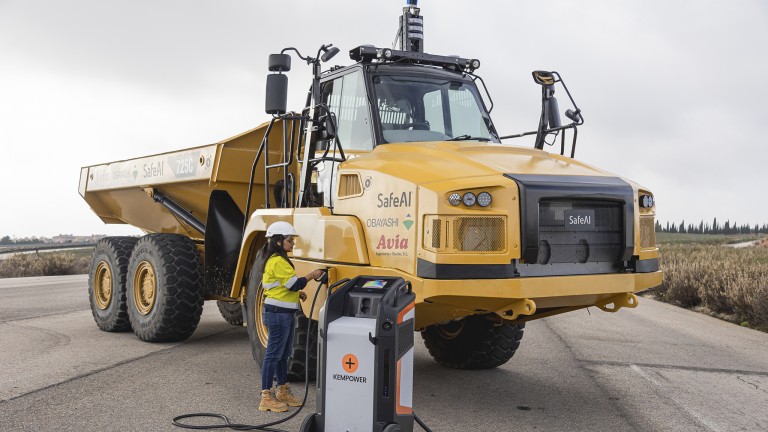A partnership between SafeAI and Obayashi has developed a retrofit zero-emission autonomous haul truck. The Caterpillar 725 is the first haul truck retrofitted with autonomous and electrification technology, a breakthrough that allows companies to reuse their existing assets while improving operations and achieving sustainability goals.
As environmental, social, and governance (ESG) goals and commitments expand among heavy construction companies, the expansion of electrification and autonomous operation is also growing. The partnership between Obayashi and SafeAI is a step forward, bringing both electrification and autonomous operation together in a retrofit situation for the first time on a haul truck.
“Just as our autonomous solution is designed to be open and interoperable to be applied to any make or model vehicle, we want our solution also to be powered by any energy source. This project is a step in that direction as it showcases how our autonomous ground vehicle stack is EV-compatible,” said Bibhrajit Halder, founder and CEO of SafeAI. “I am proud of our latest endeavour of retrofitting a Caterpillar 725, marking the world’s first haul truck retrofitted with autonomous and electrification technology. This pioneering project is a testament to our commitment to an energy-agnostic, autonomous future where efficiency and sustainability go hand in hand.”
SafeAI retrofitted the vehicle with its proven, OEM-agnostic autonomous technology for this project. AVIA Engineering, a system integrator known for its expertise in the electrification and mechatronics of trucks, retrofitted the vehicle with a fully electric drive system.
“We are proud to be a part of this project at the cutting edge of innovation,” said David Sánchez, owner and CEO of AVIA Engineering. “By retrofitting these vehicles using a 100 percent electric drive train, it allows companies to recycle their existing assets and use them in a better, more sustainable way. Our team, in collaboration with SafeAI and Obayashi, is proud to have successfully integrated a fully electric powertrain and is looking forward to seeing where this first step can take us.”
Automation and electrification together provide a range of advantages that are more difficult to achieve as independent technologies. For example, the combined uses are safer and allow for a more advanced charging infrastructure while removing employees from dangerous work environments. They can instead supervise from a distance while avoiding the need to operate or refuel vehicles.
Efficiency is improved; autonomy allows for 24/7 operations combined with electric’s lower operating costs, improving overall productivity and cost-effectiveness. Carbon-neutral goals can be met faster with the combination of technologies – autonomy improves environmental performance on work sites by up to 13 percent, and swapping diesel for electricity cuts net life cycle emissions by more than 60 percent.
Retrofitting vehicles with autonomous and electric technology reduces the upfront costs and allows for more affordable fleet upgrades.
“When we started working with SafeAI, our partnership focused on safety and productivity. Now, we’re setting our collective sights on our next goal: to usher in a sustainable future for construction,” said Sugiura Shinya, Business Innovation Division General Manager of Obayashi. “In addition to demonstrating the synergy between autonomous and electric technologies, we’re also excited about the retrofit aspect of this project. The difference between the OEM approach and this initiative is that it puts the contractor in control. A retrofit approach allows contractors to proactively upgrade their vehicles to advance carbon neutral strategies.”
Read the full article here











